Los Colores ... In Taos! In September, the Mountain and Valley Wool Association (MAVWA), sponsored its first Earth's Palette: Natural Colors for Fibers conference. Held in Taos, New Mexico in conjunction with the annual Taos Wool Festival, the conference was designed to focus our collective interest in natural dyes and pigments and the endless colors they produce. The location and the subject were perfect complements to one another. Coordinated by Liesel Orend, owner of Earth Arts, with assistance from Coralie Silvey Jones, the conference brought together an impressive group of keynote speakers from the natural color world. These included Michele Wipplinger and Kathy Hattori of Earthues, John Marshall, Pamela Feldman, editor of the Turkey Red Journal, and Taos' own Luisa Gelenter of LaLana Wools. The two and a half day conference (26-28 September, 2009) was overflowing with information from a range of fields connected to the art and the craft of using natural dyes. Focus as well was on the social, agricultural, economic, and environmental impacts of choosing natural dyes for our prized natural fibers.
The pre and post workshops offered a wealth of knowledge and were open to many skill levels. Workshop instructors included John Marshall, Michele Wipplinger, Lisa Klakulak, Liesel Orend, and Luisa Gelenter, working with her long-time assistant Maryalice Garrigan. These intensive and productive workshops covered the wide range of processes and methods used when working with natural dyes, including painting with earth pigments and soy milk; dyeing luscious wool and mohair with native southwest plants; achieving multiple color variations from a single dye pot; the cochineal color wheel; using natural dye extracts for felting; instant indigo; and growing your own dye garden. Each workshop included natural dye terminology, utilizing words like flocculate, ibana, dye liquors, slurries, bondage, and lakes.
Instructors incorporated many stories about their own experiences with natural color. Their presentations offered practical, hands-on experience and demonstrated specific techniques. In addition to geographic diversity, there were international perspectives, and varied philosophies about the use of natural color. Opportunitities for meeting with panel members and other professional participants, and working alongside them during the workshops, were vital aspects of our learning and teaching. The presenters and instructors should be applauded for their enthusiasm and willingness to share their knowledge of what works for each of them. Such dedication encourages our choice to continue to work with natural dyes and pigments.
Other rewarding aspects of Earth's Palette were to be found in the mini-sessions. These compact sessions included lectures as well as intensive hands-on workshops, with information from an array of color and academic professionals. Glenna Dean, former State of New Mexico Anthropologist, gave an extensive presentation about her research on dyeing with a variety of lichens. Sylvia Raines Dennis, a botanist and ecologist, talked about the relationship between human settlement patterns and the many cultural uses of plants, including discovering and identifying local native plants while harvesting sustainably. This presentation was complemented by Liesel Orend's workshop, "The Dye Garden," which provided information on the growing habits of many dye plants such as Hopi Sunflower, fresh indigo and woad leaves, marigolds, kota tea, madder root, peach leaves, and sumac. Common names are often used to identify plants in local areas, but the use of scientific taxonomy was encouraged to correctly identify plants species.
Other excellent presentations covered such subjects as indigo dyeing in Western Nigeria; Navajo natural dyes; mushroom dyes; exploring color combinations; pH shifting; medicinal uses of natural dye plants; and dye plant production and marketing. Also notable were presentations on the Nepal Project with Patricia Martin, Lisa Klakulak's artistic journey, and Pamela Feldman's keynote lecture about her research in "Over and Under Dyeing with Indigo." All of these in-depth sessions highlighted commitments to natural dyes across the globe.
The Gallery Walk showcased artworks utilizing natural dyes, from historic textiles to current works that push the limits of a medium that is often perceived as traditional. Due to time constraints, this aspect of the conference received the least attention, but is a valuable idea to consider for future conferences. When a conference includes local galleries, it may well result in promoting a wider interest in natural dyes within the community in which it is held. At the same time, for many out-of-town participants, visiting local galleries is an opportunity to explore a new place, or to see a familiar place with new eyes. It therefore becomes a total community event, reaching beyond the conference itself.
The final panel discussions consisted of technical Q & A with Michele Wipplinger and Pamela Feldman. Kathy Hattori discussed sustainability and market trends, covering such important resource issues as water and energy conservation when mordanting and dyeing, and the environmental and social benefits of using natural dyes.
The open discussions at the closing of the conference focused on the future. Why is Earth's Palette important? The last natural color conference in the US was in Iowa in 2002, and the last international conferences were held in Hyderbad, India in 2006, and in Daegu, Korea in 2008. As plant and color advocates, we are environmental, social and art promoters and textile conservationists. The world of natural colors emcompasses all of these fields. Although there is something mysterious about wildcrafting and the alchemy of working with natural colors and materials, there is also a wealth of science-based research that parallels the exciting work of artists. This fusion makes the field of natural colors rich in resources and layered with worldwide applications.
We offer many thanks to MAVWA for sponsoring and supporting Earth's Palette, and extend deep appreciation to Liesel Orend for dedicating her time to making it happen. A conference with this kind of connection-building and professional participation, whether small or large, builds momentum and connects a growing natural color community.
While driving home to Oklahoma, I gathered two pillowcases full of Chamisa (Chrysothamnus nauseosus) while reflecting on my favorite mantras from my two weeks in Taos. They are from Michele, John, and Luisa: "Read Your Water", "Wash Your Dirt", "Love What You Get."
By Heather Clark Hilliard
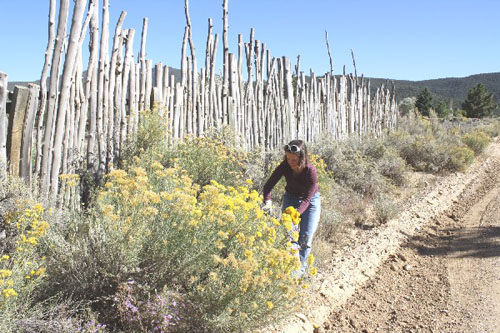

Photograph Copyright by Heather Clark Hilliard
Dyeing yarns in the "Many Faces of Cochineal" workshop
John Marshall preparing pigments in his workshop
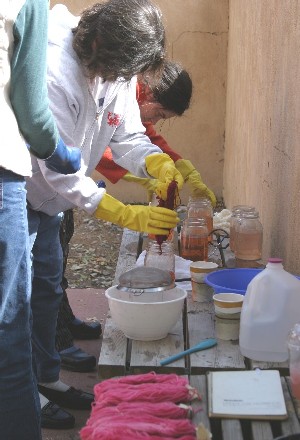

Photograph Copyright by Heather Clark Hilliard
Photograph Copyright by Pamela Feldman
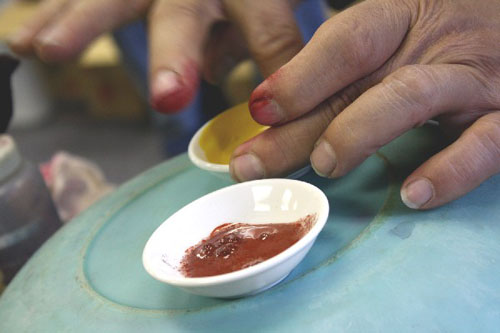
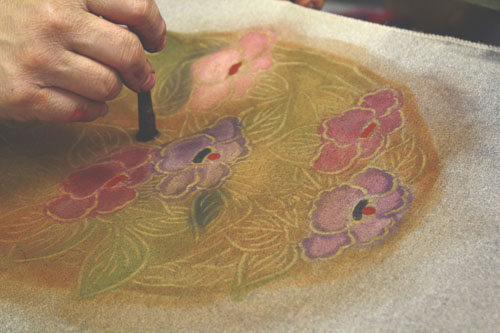
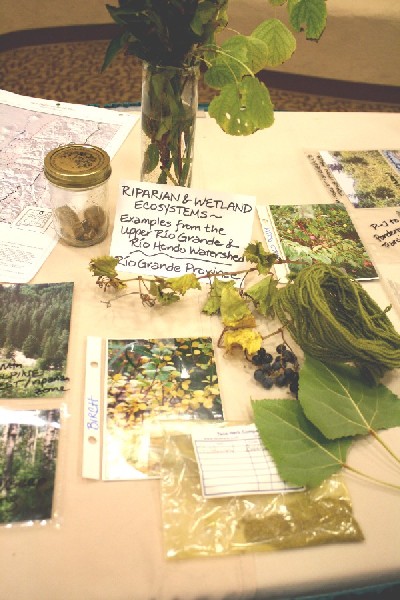
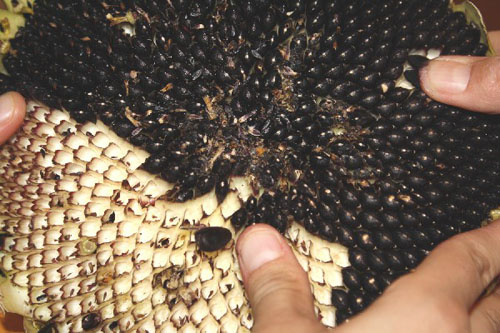
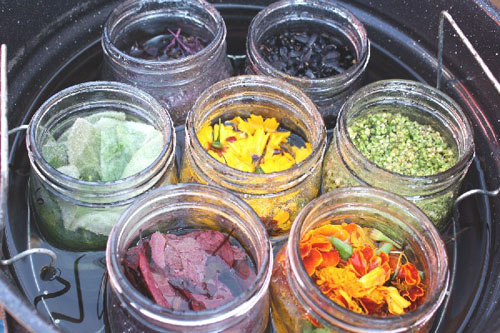
 Turkey Red Journal
Turkey Red Journal

| Volume 15 Issue 1 | A Journal Dedicated to Natural Dyes | Fall 2009 |
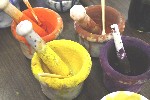
Ground pigments in John Marshall's workshop
Photograph Copyright by Heather Clark Hilliard
In this Issue
Articles:
• Introduction to Common
New Mexico Dye Lichens
• Dyeing with Fresh Leaf
Indigo ... continued
• Close Call: Saving
Japanese Indigo
Nature's Gallery:
• Jaime Skolfield
The author gathering Chamisa flowers
Photograph Copyright by Heather Clark Hilliard
Straining a fresh indigo bath in Liesel Orend's workshop
John Marshall's Tools of the Trade
Photograph Copyright by Heather Clark Hilliard
John Marshall demonstrating applying pigment highlights
Photograph Copyright by Heather Clark Hilliard
Sylvia Raines Dennis' Plant Information Display
Photograph Copyright by Heather Clark Hilliard
Harvesting Hopi Sunflower seeds in Liesel Orend's workshop
Photograph Copyright by Heather Clark Hilliard
Extracting colors from local plants in Liesel Orend's workshop
Photograph Copyright by Heather Clark Hilliard